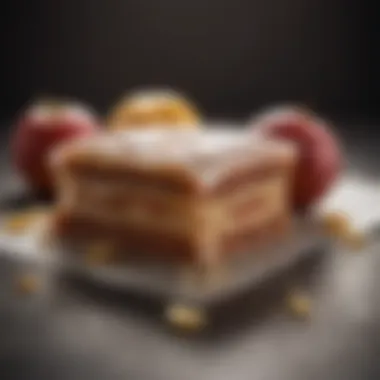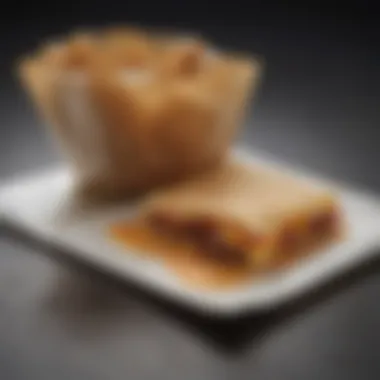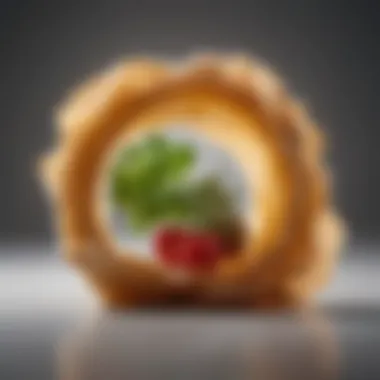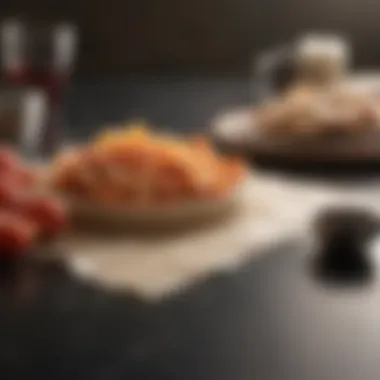Exploring the Versatility of Wax Paper: A Comprehensive Guide


Intro
Wax paper is a commonly overlooked kitchen item, yet its versatility and practicality offer a wealth of benefits. Understanding its various applications can enhance your cooking experience and streamline everyday tasks. This guide aims to shed light on the richness of wax paper beyond simple food wrapping. We will explore its applications, advantages, and considerations when using wax paper. Through this, readers will gain a clear understanding of its role not only in the kitchen but also in a broader spectrum of everyday activities.
Recipe Overview
Recipe Name
Wax Paper Sandwiches
Description of the Dish
Wax paper sandwiches are a convenient way to prepare and store sandwiches for lunch or picnics. The wax paper serves not only as a wrapping but also as a protective layer that keeps the sandwiches fresh, preventing them from becoming soggy. It's an easy option for on-the-go meals, allowing for functional and mess-free eating.
Ingredients
- Bread: 2 slices (your choice: whole wheat, white, or gluten-free)
- Deli Meat: 2 oz (turkey, ham, or vegetarian option)
- Cheese: 1 slice (cheddar, Swiss, or an alternative)
- Lettuce: 1 leaf (optional)
- Condiments: as desired (mustard, mayo, etc.)
Special Notes on Ingredients
- Bread: Considering regional variants, sourdough can also be an interesting choice for added flavor.
- Deli Meat: For those seeking healthier alternatives, grilled vegetables can be a flavorful substitution.
- Cheese: Vegan cheese options are now widely available for dietary preferences.
Tip: When packing sandwiches using wax paper, ensure to wrap tightly to maintain freshness.
In this overview, we've established a foundation for using wax paper effectively in innovative cooking solutions. Check each ingredient's compatibility based on personal dietary needs, ensuring the experience remains enjoyable and nourishing.
Prelude to Wax Paper
Wax paper, often underestimated, holds a unique status in culinary and everyday uses. Understanding its definition and properties sets the stage for evaluating its role in food preparation and storage. This section underscores the benefits of wax paper, such as its moisture resistance and non-stick qualities, which make it an invaluable kitchen tool. Exploring these facets enhances our appreciation of this versatile material and helps readers make informed decisions regarding its applications.
Definition and Properties
Wax paper is a lightweight paper that has been coated with a layer of wax, typically paraffin. This wax coating provides significant advantages, including moisture resistance and a non-stick surface. Unlike parchment paper, wax paper is not heat-resistant and should not be used in the oven. It serves well in various applications, such as wrapping food, preventing messes while cooking, or even crafting. An essential property of wax paper is its impermeability to liquids, which helps protect surfaces from spills.
In summary, wax paper features:
- A moisture-resistant coating that helps keep food fresh
- A non-stick surface ideal for rolling dough or crafting projects
- Lightweight characteristics, making it easy to handle and store
Historical Context
The origins of wax paper date back to the late 19th century. It emerged as a practical solution for food storage and preparation, quickly gaining popularity among homemakers. Initially, it was made using traditional paper manufacturing techniques combined with a wax coating to enhance its usability. Through the years, innovations in paper technology have allowed for the mass production of wax paper, leading to its widespread availability in grocery stores.
Historically, the use of wax paper has evolved beyond merely wrapping food. It has found its place in various artistic endeavors, from decoupage to protective layers in art projects. Its accessibility and versatility continue to make wax paper an enduring choice for many tasks in contemporary kitchens and crafting spaces.
"Wax paper is more than just a kitchen supply; it's a blend of practicality and history, shaping how we store and prepare our food."
Wax Paper vs. Other Types of Paper
Understanding the differences between wax paper and other paper types can greatly shape your choice when selecting materials for various tasks. While parchment paper and plastic wrap also serve as kitchen staples, each type possesses unique features influencing their utility, especially in food preparation and storage. This section will clarify these distinctions to help readers make informed decisions.
Comparison with Parchment Paper


Parchment paper is often seen as a direct alternative to wax paper, but there are significant differences to note. Parchment paper is coated with silicone, making it parchment more heat resistant. It withstands high temperatures, making it ideal for baking tasks such as lining cake pans or wrapping food for roasting. On the other hand, wax paper has a coating of wax that can melt when exposed to high heat, which effectively makes it unsuitable for baking purposes.
When discussing durability and functionality, it’s essential to acknowledge that the ideal use case may determine which paper to choose. Whereas parchment paper is used selection in temperatures up to 420°F (216°C), wax paper shines in tasks involving cold food prep and storage, such as wrapping sandwiches or lining trays for easy cleanup.
Wax Paper versus Plastic Wrap
Wax paper and plastic wrap can both serve similar roles in food storage, but they have their own merits. Plastic wrap is a versatile option favored for its ability to seal tightly and prevent air exposure, which keeps food fresh for longer periods. However, it is made from petroleum, which raises environmental concerns about sustainability.
In contrast, wax paper, being biodegradable and made from renewable materials, presents a more eco-friendlier option. Yet, wax paper does not offer the same sealing capabilities as plastic wrap, leaving some foods more exposed to air. It is not as effective in preventing moisture loss, but it works perfectly to wrap food for short-term storage. Each option presents its pros and cons, making the importance of selecting the right product based on the specific needs of the task crucial.
Advantages of Using Wax Paper
The adoption of wax paper gains traction for various reasons, highlighting its distinct advantages. First and foremost, its greaseproof nature allows for effective food preparation. Most oily and greasy foods can be handled without sticking, making it exceptional for tasks like rolling out dough or covering countertops during messy work.
"Wax paper presents versatility with its ability to handle greasiness without sticking, making it a kitchen staple for many tasks."
Another fundamental advantage is its cost-effectiveness. Usually available at affordable prices, wax paper proves to be economical for households, small businesses, and culinary professionals alike. It is easy to use, and it can serve multiple purposes in the kitchen, from food storage to baking assistance in an economical system. This multi-faceted utility indicates why wax paper remains an invaluable product in kitchens across the globe.
Common Uses of Wax Paper
Wax paper is a practical kitchen staple, known for its versatility across different culinary and craft activities. This section outlines various uses that highlight wax paper's benefits, ensuring a thorough understanding of why it is invaluable in many contexts. From preserving food to enhancing creativity in arts and crafts, its multifaceted applications emphasize its significance and reliability.
Food Storage Solutions
Food storage is perhaps one of the most common applications of wax paper. It serves effectively to wrap sandwiches, pastries, and other foods that require protection without the expense of plastic wrap. The wax coating helps to keep moisture in while preventing foods from drying out. This makes wax paper ideal for both short-term and some longer food preservation.
Moreover, it reduces food waste, allowing users to store leftovers effectively. Here are some key benefits:
- Breathability: Unlike plastic, wax paper allows foods to breathe, reducing sogginess for items like bread and baked goods.
- Nonstick surface: This property is particularly useful for sticky items such as cheese or caramel, helping to keep food intact while stored.
- Easy to use: Cutting and wrapping food in wax paper is straightforward, making it a convenient option for quick food preparation.
"Using wax paper for food storage can extend the life of your meal prep while maintaining quality."
Baking and Cooking Applications
In baking and cooking, wax paper proves beneficial in multiple ways. Its nonstick quality is well-suited for lining pans and trays when working with batters and sticky substances. Although it is not recommended for direct exposure to high heat, it can be used for pre-assembly of ingredients or as a surface for rolling dough.
Some specific uses include:
- Lining baking sheets: Prevents food from sticking and saves on cleanup.
- Rolling dough: Minimizes mess and allows for easy manipulation.
- Separating layers: Ideal for stacking cookies or pastries, preventing them from sticking together.
A common consideration for users is the proper handling of wax paper, as it can sometimes seem fragile when folded or creased. Ensuring smooth application can improve results significantly.
Arts and Crafts Uses
Beyond the realm of cooking and food storage, wax paper has significant applications in arts and crafts. Its smooth surface allows for a variety of creative pursuits, providing an ideal canvas for different techniques. For instance, it is often used in:
- Transferring designs: Artists can use wax paper to trace designs, enabling precise outline work.
- Making envelopes: Customized envelopes can be crafted easily with wax paper for special occasions.
- Layering techniques: Used in various crafts for layering colors, providing interesting textures to projects.
In summary, the common uses of wax paper span culinary applications and creative endeavors, making it a versatile tool. Recognizing its importance in both everyday cooking and creative projects encourages more people to appreciate this essential material.
Purchasing Wax Paper on Amazon


Purchasing wax paper from Amazon is a crucial segment of this guide, given the platform's vast selection and convenience. This section provides insights into what consumers should consider when buying this crucial kitchen item. With numerous brands and shapes, finding the right product can be overwhelming. Understanding the various elements such as product options, reviews, and pricing trends can significantly simplify the decision-making process.
Product Varieties and Options
When selecting wax paper, you will notice various options available on Amazon. These come in different sizes, thicknesses, and packaging types. The thickness is particularly important for specific tasks, such as baking or wrapping food. You may find rolls of wax paper, pre-cut sheets, or specialty options tailored for specific uses, like food storage or arts and crafts.
Common brands include Reynolds and If You Care. Reynolds often features heavy-duty rolls that are great for baking, while If You Care promotes eco-friendly options. Consumers should look for USDA-approved products if sustainability is a priority.
Key Considerations:
- Size: Determine what size fits your cooking or crafting needs.
- Thickness: Heavy-duty options work better for cooking.
- Eco-friendliness: Look for certified products when possible.
Evaluating Customer Reviews
Customer reviews play a critical role when purchasing wax paper on Amazon. They provide real-life insights into a product's performance and reliability. When browsing through customer feedback, pay attention to both positive and negative reviews. Users often share information about how the wax paper performs under specific conditions, such as whether it holds up well during baking or if it tears easily when wrapping food.
It's advisable to check for trends within reviews. If multiple customers mention the same issue, there could be a legitimate concern regarding the product's quality. Furthermore, often users will provide pictures that can offer a practical view of the product, making them a valuable resource during your decision-making process.
"Reading customer reviews not only helps with quality assurance but also provides useful tips for effective use of wax paper in various applications."
Pricing Trends
Understanding the pricing trends of wax paper on Amazon can help in making an informed purchase. Generally, wax paper is budget-friendly, with prices varying based on brand and type. For instance, a standard roll may range from $4 to $12 depending on size and brand reputation.
Be mindful of bulk options, as these can offer better value for frequent users. Comparing prices across different listings on Amazon will allow consumers to identify deals or promotions. Seasonal discounts may appear, especially during holidays when baking is more common. Tracking prices can also be useful if you're not in immediate need of wax paper, allowing you to buy when costs are lower.
Environmental Impact of Wax Paper
The consideration of the environmental impact of wax paper is crucial in this guide. As the culinary community seeks alternatives to single-use plastics, understanding the sustainability and biodegradability of wax paper becomes essential. The relevance lies in how this kitchen staple interacts with nature, its contribution to waste, and its overall ecological footprint. Addressing these factors will help consumers make informed choices when opting for wax paper in their daily lives.
Sustainability Considerations
Sustainability is a significant aspect of using wax paper. Unlike many plastic wraps and containers, wax paper is crafted from easily renewable resources, primarily paper. This characteristic makes it a preferable option for those concerned about the ecological impact of their purchases. Moreover, some manufacturers are now producing wax paper that uses organic waxes, enhancing its environmental friendliness. This shift toward sustainable materials can contribute to reducing overall plastic pollution in kitchens worldwide.
- Wax paper typically comes from trees, which are a renewable resource.
- Many brands offer organic wax paper that is free from harmful chemicals.
- Utilizing wax paper when preparing food helps minimize reliance on plastic wraps, promoting a healthier planet.
However, consumers should consider the production process and a manufacturer’s practices. Opting for brands committed to responsible sourcing can further ensure that the sustainability of their product aligns with their values.
Biodegradability of Wax Paper
Another significant characteristic of wax paper is its biodegradability. Unlike plastic, which may take hundreds of years to decompose, wax paper is made from biodegradable materials that can break down in a matter of months under the right conditions. This rapid decomposition means it is not a burden on landfills, contributing to a reduced environmental footprint.
Furthermore, when disposed of correctly, wax paper can even enrich soil, as it returns nutrients to the earth. This environmental benefit is vital for those who prioritize composting and sustainable waste management practices.
"Choosing biodegradable products like wax paper allows individuals to actively participate in environmental preservation."
In summary, wax paper not only serves practical purposes in the kitchen but also presents a more sustainable and biodegradable option compared to traditional plastic alternatives. By considering the implications of its use, consumers can make choices that align with an eco-friendly lifestyle.
Expert Tips for Using Wax Paper
Using wax paper effectively can streamline various processes, particularly in the kitchen. Understanding the best practices when using wax paper can enhance cooking experiences and increase efficiency. Here, we dive into pragmatic advice for optimizing the use of this versatile material, ensuring food lovers can maximize its benefits while minimizing inconvenience.


Best Practices in Food Preparation
When it comes to food preparation, wax paper plays a significant role. Here are some fundamental guidelines to follow:
- Surface Protection: Use wax paper to protect countertops and tables from spills and messes. This not only keeps preparation areas clean but also makes for easier cleanup afterward.
- Prevent Sticking: When rolling out dough, place wax paper under the dough. This prevents it from sticking to surfaces and helps in easily lifting it when it's time to transfer to a baking sheet.
- Separation of Layers: For baked goods, insert wax paper between layers of cookies or cakes to avoid them sticking together. This is especially useful for keeping desserts fresh and intact.
- Microwave Safety: Many people mistakenly use plastic wrap in the microwave, but wax paper is a safer alternative for microwaving certain foods. It allows moisture to escape while preventing it from splattering on the microwave walls.
Avoiding Common Mistakes
While wax paper is generally easy to use, a few common mistakes can diminish its effectiveness. Here are several pitfalls to avoid:
- Not Using for Baking: It is important to note that wax paper is not suitable for lining baking sheets in an oven. Its wax coating can melt and even smoke, which could compromise the flavor and texture of food. Instead, opt for parchment paper for oven use.
- Ignoring the Limited Functionality: Although wax paper is useful for short-term food storage, it is not as effective as plastic wrap for longer durations. It is best for wrapping foods that will be consumed quickly or for protecting food in the refrigerator.
"Understanding wax paper's limitations is essential in ensuring its effective use in the kitchen."
- Using with High Heat: Avoid exposing wax paper to direct high heat, as this can lead to unexpected melting or smoking. Always consider the temperature when using it around food preparation.
By understanding these expert tips, one can use wax paper in a more informed way, enhancing overall food preparation and enjoyment.
Alternative Products to Consider
As the versatility of kitchen supplies expands, alternative products to wax paper deserve careful consideration. These alternatives can fulfill similar roles while potentially offering benefits that wax paper does not. Understanding these options is important for anyone interested in optimizing food preparation and storage solutions. This section explores two popular products: reusable food wraps and silicone baking mats. Both options provide unique features that can enhance your culinary tasks while aligning with eco-friendliness and user convenience.
Reusable Food Wraps
Reusable food wraps are an outstanding substitute for wax paper, especially when it comes to food storage. Typically made from organic cotton infused with beeswax, tree resin, and jojoba oil, these wraps mold to the shape of food or containers when pressed gently with hands. This feature not only keeps food fresher longer but also aids in reducing plastic waste significantly.
Benefits of Reusable Food Wraps:
- Sustainability: Unlike single-use products, reusable wraps can last for up to a year or more, depending on care.
- Versatility: They can cover bowls or wrap sandwiches. The variety in sizes available serves various packing needs.
- Freshness: Their breathable nature lets your food stay fresh while preventing moisture traps that can lead to spoilage.
However, users must keep in mind that these wraps are not ideal for use with raw meat or in high-temperature scenarios. Washing them without hot water and harsh detergents is key to maintaining their lifespan.
Silicone Baking Mats
Silicone baking mats are another compelling alternative to wax paper, particularly for cooking and baking applications. Made from food-grade silicone, these mats provide a non-stick surface, making them ideal for cookies and pastries. They eliminate the need for adding oils or sprays, thus making them a healthier option.
Benefits of Silicone Baking Mats:
- Non-stick Surface: Cooking on silicone reduces the chance of food sticking, ensuring easier removal and less mess.
- Heat Resistance: Silicone can withstand high temperatures, making it suitable for a variety of oven tasks.
- Durability: Reusable for years, silicone mats are easy to clean and can tolerate repeated use without degradation.
Both reusable food wraps and silicone baking mats serve as practical alternatives to wax paper. By considering their features, users can choose products that complement their cooking and storage needs while contributing positively to the environment.
Culmination
The conclusion of this article serves to synthesize the diverse aspects of wax paper and its relevance in multiple domains. Wax paper is not merely a kitchen necessity but a versatile tool that bridges various uses, from food storage to arts and crafts. Understanding its properties, advantages, and alternatives enriches one's knowledge and enhances practical applications in daily life.
Key elements discussed include:
- The fundamental characteristics of wax paper that make it a practical choice for food preparation and storage.
- A detailed comparison with other materials, such as parchment paper and plastic wrap, highlighting the unique benefits wax paper offers.
- The environmental considerations surrounding its use, particularly regarding sustainability and biodegradability. This is increasingly relevant in today’s eco-conscious society.
- Expert tips and tricks for utilizing wax paper effectively in the kitchen, aiding users in avoiding common pitfalls that might reduce its functionality.
Consequently, this article aims to equip readers with a well-rounded comprehension of wax paper. By addressing various applications, consumer behavior, and the product's environmental footprint, the goal is not only to inform but also to empower food lovers of all ages to make better culinary choices.
In the ever-evolving landscape of kitchen tools, wax paper stands out for its pragmatic uses and sustainable qualities. As readers reflect on the insights shared, it’s hoped they will appreciate wax paper as an invaluable asset, integrating it into their cooking and crafting endeavors with greater awareness.
"Understanding wax paper's versatility will undoubtedly enhance your culinary experience, making it a staple in your kitchen."
With this foundational knowledge, readers are encouraged to explore, use, and advocate for the applications of wax paper in their culinary pursuits.







